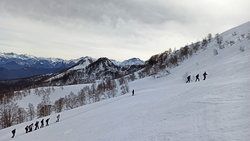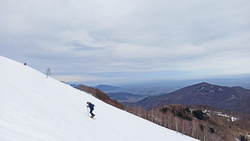SAFETY TIPS


Walking in an evocative environment such as a snow-covered mountain is an irresistible attraction for many nature lovers, but the magical atmosphere that one breathes must not make one forget that one is still in a potentially dangerous context and therefore should not be challenged but enjoyed with due respect made up of knowledge and precautions. The greatest danger is undoubtedly that of being swept away by an avalanche, i.e. a mass of snow, of varying size, which falls quickly down into the valley. Various types of avalanche can be classified according to the type of snow, the area of detachment, sliding and deposit, but they all have two origins: spontaneous or provoked detachment. The first can occur without any external cause, but due to the natural evolution of the snow layers, and can therefore occur much higher up than the path of the hiker, who may still be involved. The second case is caused by an external intervention, such as the passage of a snowshoe hiker or other person who, by overloading the slope, breaks the balance and causes all or part of the snowpack to flow downhill. There are no absolutely certain methods for predicting avalanches, it is certainly important to be able to assess the terrain, the type of snow and the climatic conditions, but if in doubt, it is a good rule to... give up or change your route! It is therefore important to plan the excursion carefully in all its aspects, from clothing to food and drink (springs or fountains present in summer are not always available in winter), without forgetting to check the efficiency of your equipment. Checking the weather forecast is essential: there are numerous, specific and reliable sites on the Internet and, although less localised, on television and in newspapers. It is also compulsory to consult the avalanche danger bulletin on the regional website www.arpa.piemonte.it/bollettini, or the national website www.aineva.it, which is classified for each zone and for easier understanding, using the colours and numbers (1, yellow, low risk up to 5, intense red, very high risk) of the "European avalanche danger scale". (Please note, however, that examining and reading the avalanche bulletin does not in any way mean that you can neglect the continuous evaluation of the conditions that you will encounter during your hike. Elements such as fog, wind, ice and early darkness should not be ignored when planning your outing. The level of training and experience of your companions can also be a determining factor in the success of your day in the snow.
With regard to the provision of avalanche rescue equipment (avalanche transceiver, shovel and probe), the Piedmont Region has passed legislation to this effect:
Regione Piemonte , Modification of regulations for off-piste snow activities.
Regional Law n. 26 of 22 December 2015 Article 53 paragraph 5:
Paragraph 2 of Article 30 of LR n 2 of 2009 is replaced by the following:
"2. Those who practice ski mountaineering, off-piste skiing and hiking activities in snowy environments, including snowshoeing, outside the slopes and areas, as defined in Article 4, paragraph 2, letters a), b), c), d), e), and g) of any routes identified and marked by the municipalities, do so at their own risk. The same persons are required to scrupulously comply with the information disseminated by public bodies or other persons authorised to officially provide such information, regarding the risks associated with carrying out this activity and to equip themselves, where, due to weather and snow conditions, there are clear risks of avalanches, with appropriate electronic signalling and search systems, shovels and snow probes to guarantee an appropriate rescue intervention"
Regardless of what the law says, being equipped with avalanche rescue equipment means, above all, being able to use it, which means practising frequently and, preferably, in real environmental conditions. In the event of a self-rescue, however, it is imperative that you first alert the mountain rescue service by dialling 112. If you would like to spend a day in the snow, minimising the risks and benefiting from the knowledge and experience of a professional, you should contact an Alpine Guide or a Mountain Guide.
Global M....
Accompanies Valle Stura.....but we, remember that we do not have, except in personal cases, adequate training on snowy terrain and therefore it should be explained that, in theory, we can only accompany on "Nordic" terrain, ie Festiona and Aisone (slopes) if I'm not mistaken.
